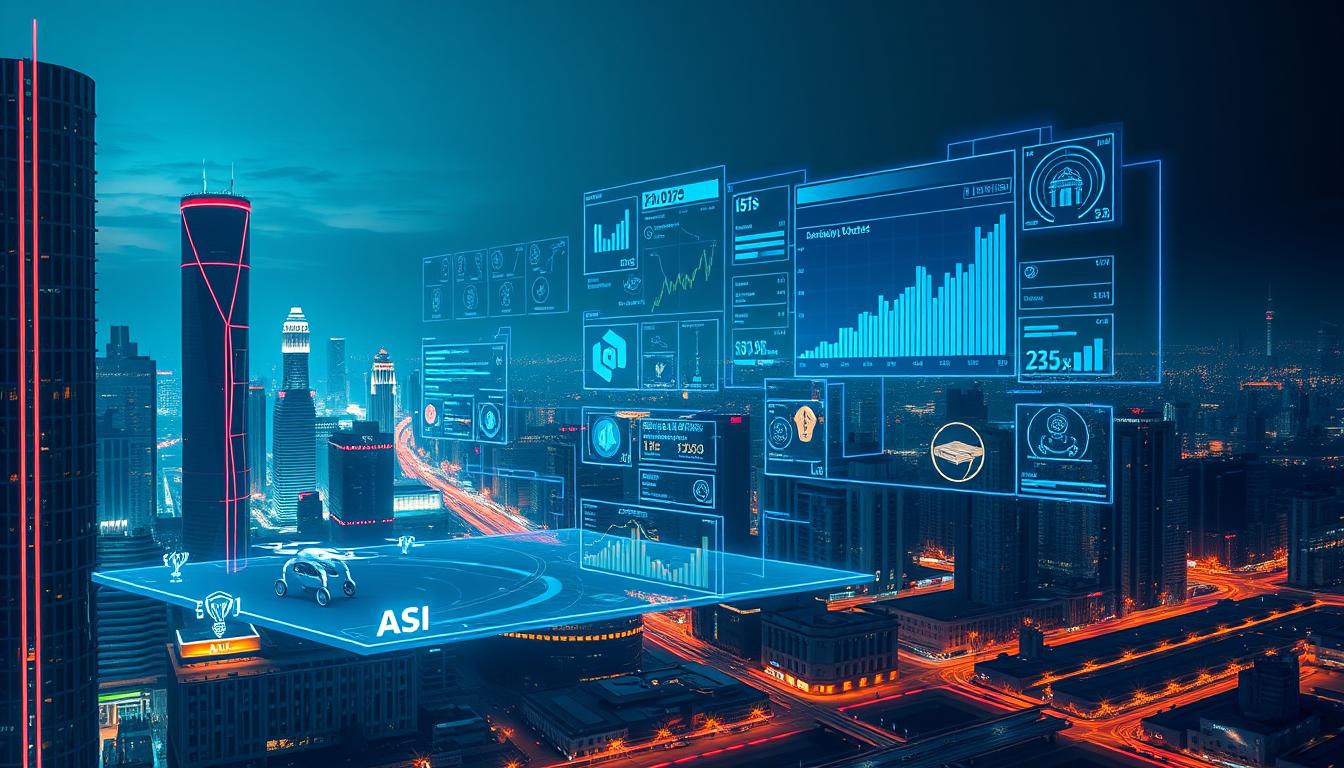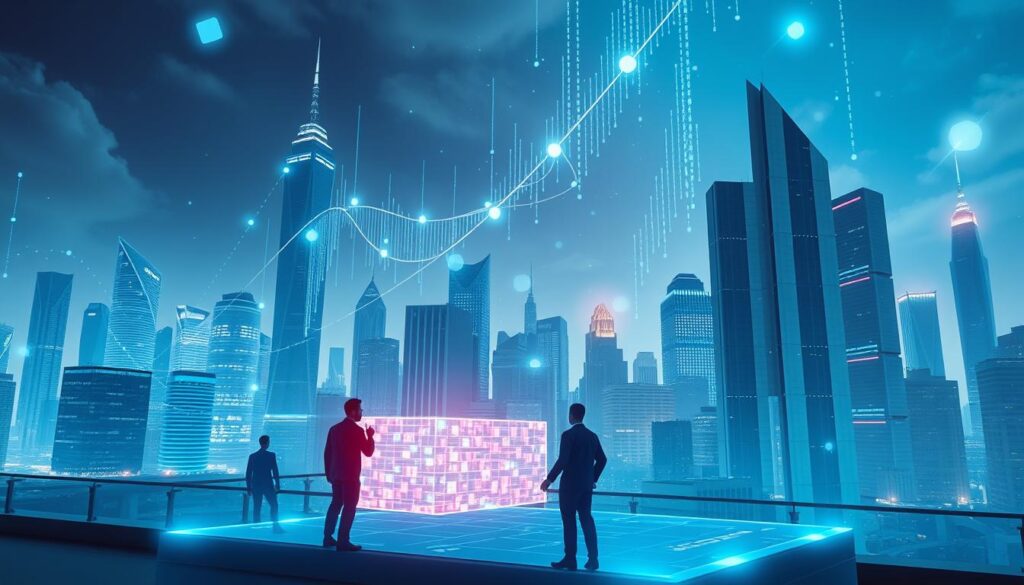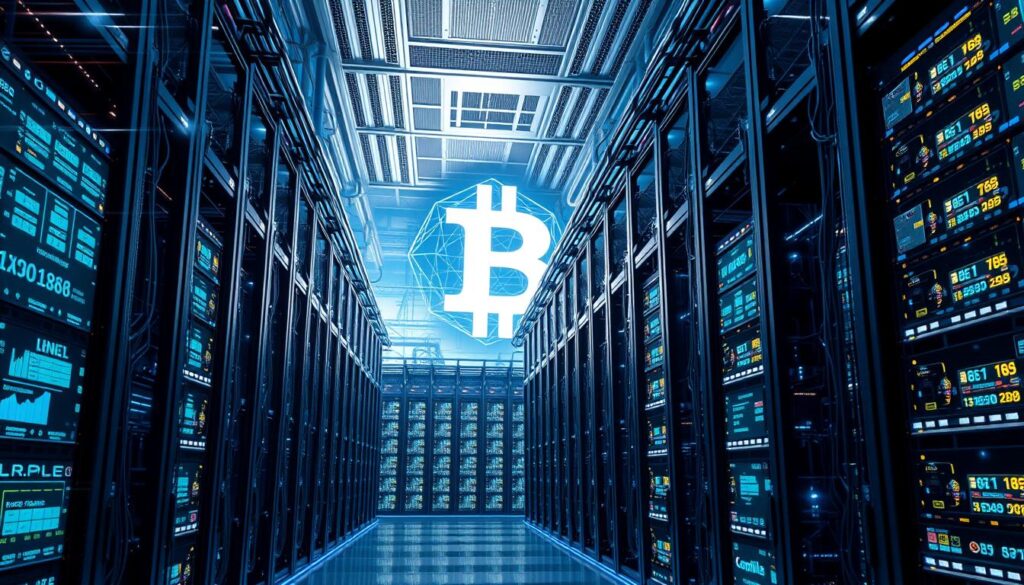Now Reading: Future of AI and Cryptocurrency Integration Trends Explained
- 01
Future of AI and Cryptocurrency Integration Trends Explained
Future of AI and Cryptocurrency Integration Trends Explained

Two powerful forces are reshaping our digital world. Artificial intelligence and blockchain technology are converging. This combination creates a new landscape for innovation.
The numbers tell a compelling story. The AI-blockchain sector is projected to grow from £0.5 billion in 2025 to over £3 billion by 2033. This represents a 24% compound annual growth rate.
Global crypto adoption is also accelerating. The total market capitalization now exceeds $3.6 trillion. Bitcoin recently reached a price of $96,409.
Institutional acceptance is clear. BlackRock’s spot Bitcoin ETF became the fastest-growing investment product. It accumulated $13.5 billion in assets under management in just three months.
This integration moves beyond theory. By 2050, the DePIN compute market could reach £1.2 trillion. Experts predict 85% of AI inferences will be verifiable on-chain.
These trends signal a major shift. We are moving from experimentation to real-world application. The blend of AI’s intelligence with blockchain‘s security unlocks new potential.
Key Takeaways
- The combination of AI and blockchain is creating a powerful new technological landscape.
- Market data shows explosive growth in the AI-blockchain sector, with a 24% annual growth rate.
- The cryptocurrency market has matured into a multi-trillion dollar asset class.
- Major financial institutions like BlackRock are rapidly adopting crypto products.
- Long-term projections indicate a massive potential market for decentralized physical infrastructure networks (DePIN).
- A significant majority of AI processes are expected to be verifiable on blockchain networks in the coming decades.
- This integration represents a practical shift from concept to implementation, empowering individuals and businesses.
Understanding the future of AI and cryptocurrency integration trends
At the intersection of machine learning and decentralized networks lies a revolutionary technological paradigm. This convergence creates systems where artificial intelligence operates on trustless platforms.
Defining the Integration of AI and Blockchain
The combination represents more than technical integration. It creates synergistic systems where algorithms validate outputs through cryptographic verification.
Thought leaders provide crucial insights. Vitalik Buterin explores governance enhancements through cognitive computing. Ben Goertzel pioneers decentralized AGI via SingularityNET.

The Evolution of Market Dynamics Over Time
Market evolution shows substantial growth. The agent token sector reached £11 billion valuation. One million active wallets demonstrate practical deployment.
This shift moves beyond speculative trading. AI enhances blockchain functionality in multiple areas. Smart contract optimization and fraud detection see major improvements.
Practical applications are already emerging. Traders can leverage advanced AI tools for crypto trading that utilize these integrated systems. The technology creates new paradigms for data processing.
This foundation prepares readers for specific advancements detailed later. The transformative potential of this integration becomes clear through established definitions and historical context.
Technological Advancements Fueling the Convergence
The engine of this powerful convergence is a series of specific technological leaps. These breakthroughs are making the combination of intelligent algorithms and secure, decentralized networks not just possible, but practical and scalable.

AI Algorithms Transforming Crypto Trading and Risk Management
Machine learning models are revolutionizing the crypto markets. They process enormous datasets in real-time, forecasting price movements and automating complex strategies.
This technology significantly reduces human error. By 2025, an estimated 60% of trades on major exchanges are driven by this form of intelligence.
Blockchain Innovations: Decentralized Compute and Smart Contracts
On the blockchain side, key innovation focuses on decentralized computing. This creates a new infrastructure for AI development.
- Decentralized Physical Infrastructure Networks (DePIN): Platforms like io.net and Akash have created a £4 billion market. They offer tokenized GPU marketplaces, rewarding contributors of computational power.
- Zero-Knowledge Machine Learning (ZKML): This technology combines cryptographic proofs with machine learning. Tools like EZKL allow AI inferences to be verified on-chain without exposing private data.
- Dynamic Smart Contracts: Moving beyond static rules, these contracts can now adapt in real-time to market shifts. This development creates more responsive finance applications.
This decentralized AI infrastructure, as explored in a recent analysis, tackles the scalability and privacy issues of centralized models. It establishes a foundation for the next wave of blockchain applications.
Impacts on Trading, Security, and Decentralized Finance
Autonomous software agents are actively reshaping how digital assets are traded and secured. These intelligent systems deliver concrete improvements across three critical areas.
Enhancing Trading Efficiency with AI Agents
Intelligent agents now handle complex trading strategies. They manage liquidity and execute transactions with precision.
Over one million active agent wallets operate today. Major platforms like Coinbase’s AgentKit and UniswapX lead this change.
These tools use intent-based systems. Users state their desired outcome, and the agent finds the best path. This approach also protects against costly MEV exploits.

Fraud Detection and Cybersecurity in Crypto Systems
Anomaly detection is vital for security. AI scans data to spot fraudulent transactions instantly.
This capability is crucial in pseudonymous crypto networks. Tools from groups like Flashbots could reduce fraud by 40% by 2027.
This protects users and builds trust in the ecosystem. It identifies money laundering and other cyber threats in real-time.
Streamlining Decentralized Finance Operations
In decentralized finance, automation is key. AI manages yield farming and optimizes liquidity governance on platforms.
Predictive models anticipate price changes. They execute trading decisions faster than any human, free from emotional bias.
This automation reduces operational risks and costs. It makes sophisticated strategies accessible to more users.
Decentralized AI Models and Blockchain in Financial Innovation
Financial innovation is being reshaped by decentralized artificial intelligence models built on blockchain infrastructure. This shift moves control from large corporations to distributed networks. It creates more transparent and equitable systems for everyone.

Tokenized Services and Data Marketplaces
Tokenized services reward contributions to AI development. Computational power, training data, and algorithm improvements earn cryptocurrency incentives. This establishes new economic models that democratize access to advanced capabilities.
Platforms like Ocean Protocol create secure data marketplaces. Hospitals can run analysis on private datasets without exposing sensitive information. This solves critical privacy challenges in regulated sectors.
SingularityNET enables algorithm sharing and monetization. Developers can combine and improve models collaboratively. Smaller participants gain access to sophisticated tools previously reserved for large companies.
Integrating AI with Decentralized Infrastructures for Compliance
Blockchain networks embed compliance through transparent, auditable processes. Chainlink’s DECO technology uses TLS proofs for data provenance. This creates verifiable chains of custody for AI training and inference.
Integration with decentralized finance infrastructure addresses regulatory needs. By 2028, over 11% of DAOs will employ AI treasury agents. These agents manage policies and execute financial decisions autonomously.
These innovations ensure users retain control over their data. Creators are fairly compensated for their contributions. The system balances privacy with strict regulatory requirements effectively.
Real-World Applications and Emerging Crypto Projects
The theoretical potential of intelligent systems combined with blockchain is rapidly materializing into practical, high-impact applications. These projects deliver measurable value across finance, investment analytics, and decentralized machine learning.
Adoption of AI-driven analytics in DeFi platforms
Platforms like Token Metrics lead this adoption. They combine machine learning with expert analysis to provide investors with deep data insights.
These tools analyze price movements, market sentiment, and project fundamentals. This helps identify new opportunities while managing trading risks for digital assets.
Case studies: Bittensor, Artificial Superintelligence Alliance, and Numeraire
Bittensor (TAO) creates a decentralized market for machine learning. Its unique system rewards participants for useful AI model contributions.
The Artificial Superintelligence Alliance (FET) combines Fetch.ai, SingularityNET, and Ocean Protocol. This collaboration accelerates decentralized technology development with a focus on ethical business models.
Numeraire (NMR) showcases a novel approach. It functions as a hedge fund using crowdsourced predictions from data scientists. Contributors are rewarded based on their model’s accuracy, blending research with real-world investment.
Mainstream adoption is also evident. Starbucks’ Odyssey platform engaged over 100,000 members, proving blockchain’s utility beyond core crypto applications. Solana’s significant DEX volume growth further validates the commercial viability of these advanced platforms.
Challenges, Risks, and Regulatory Considerations
Several substantial risks could slow progress if not properly managed. Addressing these hurdles is essential for sustainable growth.
Overcoming regulatory impediments and energy efficiency issues
Governments worldwide are crafting rules for crypto systems. The lack of clear, global standards creates uncertainty. This slows institutional adoption and complicates cross-border operations.
Energy consumption remains a key concern. Intensive computations for blockchain and machine learning drive high costs. New consensus mechanisms are emerging to improve efficiency.
These innovations aim to reduce environmental impact significantly. Balancing compliance with technological innovation is a continuous effort.
Mitigating risks such as MEV amplification and AI agent safety gaps
MEV (Maximal Extractable Value) amplification is a major security threat. Bad actors can manipulate transaction order to extract value from users. Organizations like Flashbots are building protective systems.
Autonomous AI agents present another set of risks. Safety gaps could lead to unintended financial decisions. Robust testing and fail-safes are critical for safe adoption.
Other challenges include price volatility and quantum computing threats. Ongoing research focuses on quantum-resistant protocols to protect cryptocurrencies. Solving these issues strengthens the entire infrastructure.
Conclusion
Strategic planning, such as the ‘FutureBack’ approach, is essential to navigate this complex evolution successfully. Projections indicate extraordinary growth, with revenues exceeding £8 billion by 2030 and over 100 million active agent wallets.
The market for decentralized physical infrastructure is set to expand into the trillions. This supports advanced applications in agriculture and urban analytics.
For investors and businesses, significant opportunities exist in emerging projects and compliant infrastructure. The tokenization of real-world assets will revolutionize investment and liquidity.
While challenges around security and costs remain, the trajectory is clear. This synthesis will create more efficient, transparent, and intelligent systems for all users.
FAQ
What is the core concept behind integrating AI with blockchain?
The integration combines artificial intelligence’s data-processing power with blockchain’s secure, transparent ledger. This creates systems where AI can analyze on-chain data for insights, while blockchain provides a trusted foundation for AI operations and data marketplaces.
How is AI currently improving cryptocurrency trading?
AI algorithms enhance trading by analyzing vast amounts of market data to predict price movements and manage risk. They can execute trades at high speeds and identify complex patterns that are difficult for humans to see, increasing overall market efficiency and liquidity.
What role does blockchain play in the development of AI?
Blockchain offers a decentralized infrastructure for AI development. It can enable secure data marketplaces where users control their information, provide transparent audit trails for AI decisions, and facilitate decentralized computing power for training complex models, reducing costs and centralization.
Can AI make decentralized finance (DeFi) platforms safer?
Yes, AI significantly boosts security in DeFi. It can continuously monitor transactions for fraudulent patterns, detect smart contract vulnerabilities, and identify sophisticated hacking attempts in real-time, helping to protect user assets and maintain platform integrity.
What are some real-world projects combining AI and crypto?
Several pioneering projects are leading this convergence. Bittensor operates a decentralized network for machine intelligence. The Artificial Superintelligence Alliance focuses on creating a decentralized AI ecosystem. Numeraire uses cryptographic technology to power its hedge fund’s predictive models, showcasing practical investment applications.
What are the main risks associated with AI and crypto integration?
Key risks include potential regulatory challenges as technologies evolve, the amplification of Miner Extractable Value (MEV) by intelligent bots, and security gaps in autonomous AI agents. Ensuring energy efficiency and robust compliance frameworks are also critical challenges for sustainable growth.











